Thunderbolt 3 in Action: Akitio Thunder3 Duo Pro DAS Review
by Ganesh T S on April 14, 2016 8:30 AM EST- Posted in
- Storage
- DAS
- Thunderbolt 3
- Akitio
Direct-Attached Storage Performance
Given the presence of two bays, it is clear that the system needs to be fitted with SSDs in order to deliver maximum performance. We chose two Intel DC S3510 240GB SSDs as the members of a RAID-0 array for benchmarking purposes. Prior to taking a look at the real-life benchmarks, we first check what ATTO and CrystalDiskMark have to report.
ATTO shows performance numbers close to 800 MBps for large-sized reads, and it is backed up somewhat by CrystalDiskMark also.
In order to tackle the first real-life use-case, we created three test folders with the following characteristics:
- Photos: 15.6 GB collection of 4320 photos (RAW as well as JPEGs) in 61 sub-folders
- Videos: 16.1 GB collection of 244 videos (MP4 as well as MOVs) in 6 sub-folders
- BR: 10.7 GB Blu-ray folder structure of the IDT Benchmark Blu-ray (the same that we use in our robocopy tests for NAS systems)
| Akitio Thunder3 Duo Pro + 2x Intel SSD DC S3510 (Thunderbolt 3) robocopy Benchmarks (MBps) |
||
| Write Bandwidth | Read Bandwidth | |
| Photos | 526.00 | 398.80 |
| Videos | 522.75 | 538.06 |
| Blu-ray Folder | 525.68 | 568.55 |
The above benchmark run was also instrumented to record the temperature of one of the SSDs as well as the instantaneous transfer rate to the DAS unit during the process. The internal disk temperature never exceeded 38 C even after more than 127 GB of writes and 127 GB of reads continuously.
For the second use-case, we take advantage of PC Mark 8's storage bench. The storage workload involves games as well as multimedia editing applications. The command line version allows us to cherry-pick storage traces to run on a target drive. We chose the following traces.
- Adobe Photoshop (Light)
- Adobe Photoshop (Heavy)
- Adobe After Effects
- Adobe Illustrator
Usually, PC Mark 8 reports time to complete the trace, but the detailed log report has the read and write bandwidth figures which we present in our performance graphs. Note that the bandwidth number reported in the results don't involve idle time compression. Results might appear low, but that is part of the workload characteristic. This is not the intended use-case for portable hard drives, but the results are just presented here for the sake of completeness
| Akitio Thunder3 Duo Pro + 2x Intel SSD DC S3510 (Thunderbolt 3) PCMark8 Storage Benchmarks (MBps) |
||
| Write Bandwidth | Read Bandwidth | |
| Adobe Photoshop (Light) | 612.44 | 167.14 |
| Adobe Photoshop (Heavy) | 578.53 | 225.74 |
| Adobe After Effects | 265.09 | 227.90 |
| Adobe Illustrator | 488.68 | 217.72 |
While the above numbers are very good, and what one expects from two SSDs in RAID-0, they do not bring out the real capabilities of Thunderbolt 3. For that purpose, we need to daisy chain multiple units.
Prior to looking at the daisy chaining results, let us see how the unit performs when fitted out with a couple of high-capacity hard disks in RAID-0. This is probably the configuration that most users would choose when looking for large amounts of fast and affordable storage. Two 8TB Seagate Enterprise NAS HDDs were installed in one of the units and all benchmarks that were run for the SSD configuration were repeated.
Note that the HDD configuration provides lower bandwidth, but much higher consistency. There is also not much benefit to higher queue depths in this configuration. The consistency aspect is also brought out in the performance consistency test.
| Akitio Thunder3 Duo Pro + 2x 8TB Seagate Enterprise NAS HDDs (Thunderbolt 3) robocopy Benchmarks (MBps) |
||
| Write Bandwidth | Read Bandwidth | |
| Photos | 346.22 | 301.99 |
| Videos | 376.31 | 348.88 |
| Blu-ray Folder | 372.49 | 375.63 |
| Akitio Thunder3 Duo Pro + 2x 8TB Seagate Enterprise NAS HDDs (Thunderbolt 3) PCMark8 Storage Benchmarks (MBps) |
||
| Write Bandwidth | Read Bandwidth | |
| Adobe Photoshop (Light) | 316.60 | 9.93 |
| Adobe Photoshop (Heavy) | 292.50 | 12.45 |
| Adobe After Effects | 71.11 | 9.58 |
| Adobe Illustrator | 204.77 | 9.06 |
We now move on to the results from our daisy-chaining experiments.


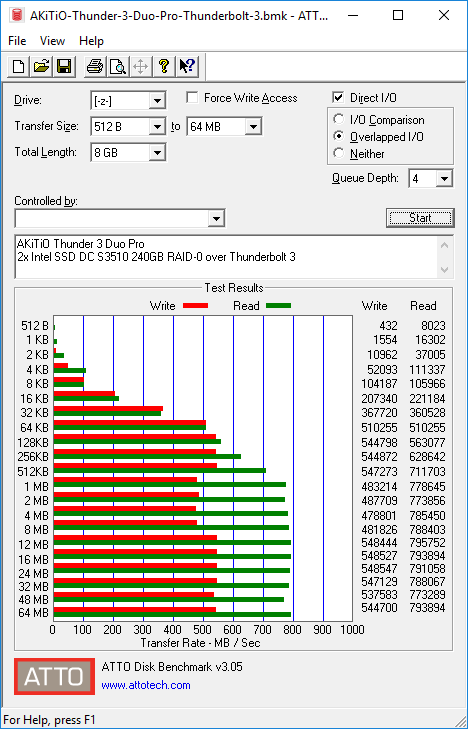
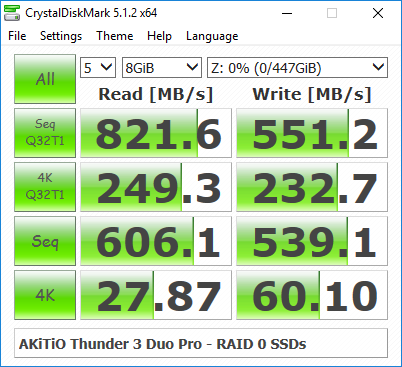

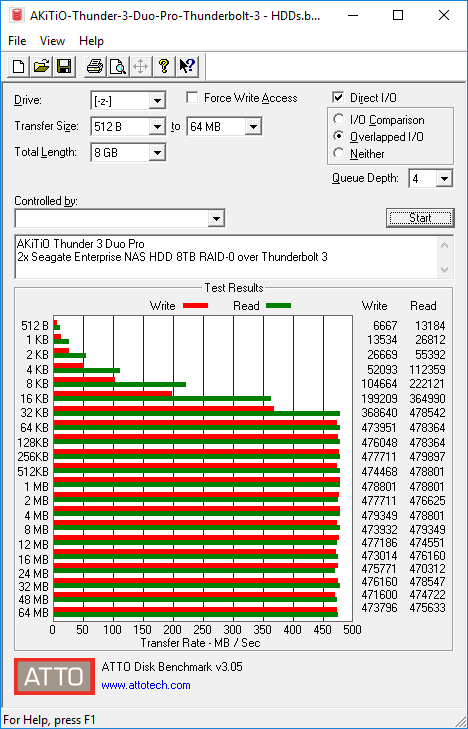
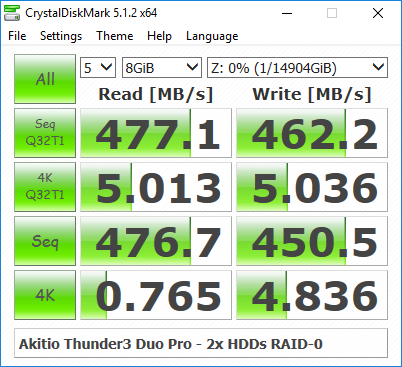
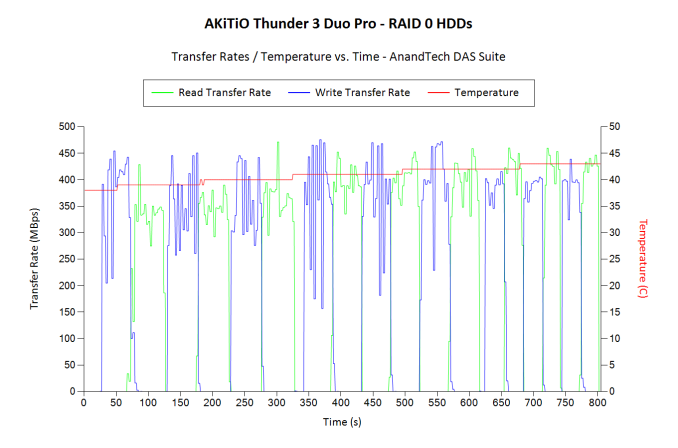








60 Comments
View All Comments
danbob999 - Thursday, April 14, 2016 - link
you are probably limited by your HDD speed, not USB3DanNeely - Thursday, April 14, 2016 - link
Depends how sequential the io is. Hdds are ~3x faster than usb2, so 4 hdds could bottleneck a 3.0 port.danbob999 - Thursday, April 14, 2016 - link
They could in some rare case for short periods of time. In the real world, no one will even notice the speed reduction from USB 3.0. Speed will often be much lower, especially on writting, and even more if using RAID1.joos2000 - Friday, April 15, 2016 - link
It's obviously not a raid 1 array though.theduckofdeath - Saturday, April 16, 2016 - link
You're not trying to argue someone is using RAID 0 for data backup, are you? :DSpetsnazAntiVIP - Thursday, April 14, 2016 - link
You would probably be better off building a NAS or SAN server using a hot swap server case or rack, a used $70 Xeon E5 2670, and connecting it to your PC with a 40 Gbps Infiniband link. Used 40 Gbps Infiniband PCIe cards are <$40 on eBay. Infiniband cables can be had for <$15. All of the server parts can be had used on eBay for cheap. You would have much more robust setup, much more configurable storage, better fault tolerance, be able to use more fault tolerant file systems like ZFS or CephFS, and the ability to upgrade and swap faulty parts, rather than replacing the whole storage solution. It would also probably be cheaper than an off the shelf 8 drive solution.SpetsnazAntiVIP - Thursday, April 14, 2016 - link
Check out this writeup on an E5 2670 dual CPU build for an idea of how fast these processors are for $70 a pop used: http://www.techspot.com/review/1155-affordable-dua...zodiacfml - Friday, April 15, 2016 - link
Yup. I was not impressed with the product and the technology. Type-C is a convenience thing though and not performance. A decent NAS can keep up with this.sor - Thursday, April 14, 2016 - link
I really dislike the fact that we've got a single type of port with a dozen varieties of logos on either side, but I suppose it is better than a dozen ports. I wonder what we will do in the following generations as more protocols and protocol versions are added.Meteor2 - Friday, April 15, 2016 - link
That's the whole point of TB3. It unifies the lot.